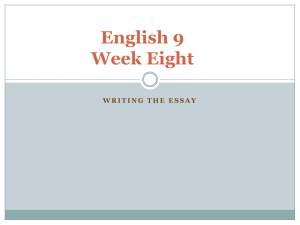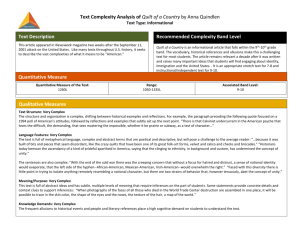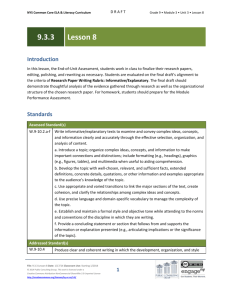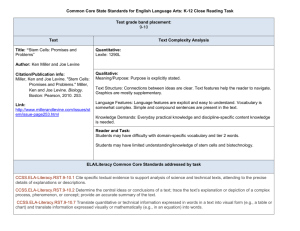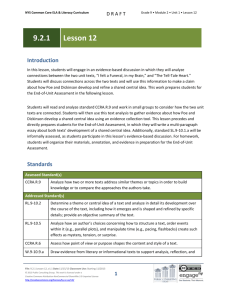10.2.2 End-of-Unit Assessment
advertisement
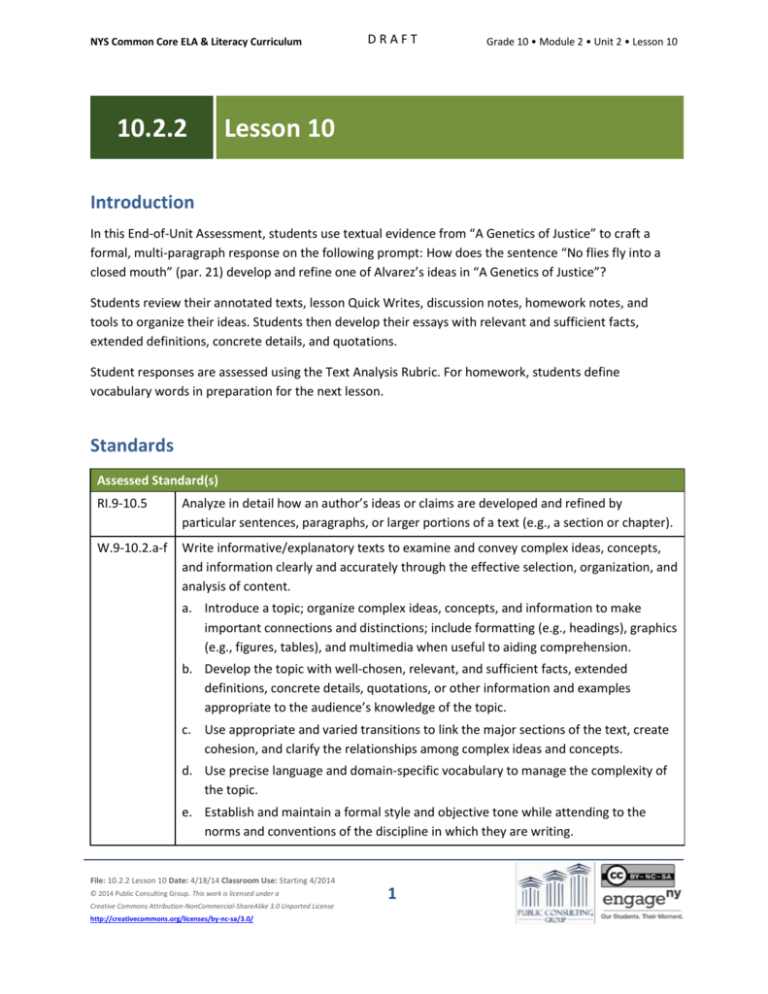
NYS Common Core ELA & Literacy Curriculum 10.2.2 DRAFT Grade 10 • Module 2 • Unit 2 • Lesson 10 Lesson 10 Introduction In this End-of-Unit Assessment, students use textual evidence from “A Genetics of Justice” to craft a formal, multi-paragraph response on the following prompt: How does the sentence “No flies fly into a closed mouth” (par. 21) develop and refine one of Alvarez’s ideas in “A Genetics of Justice”? Students review their annotated texts, lesson Quick Writes, discussion notes, homework notes, and tools to organize their ideas. Students then develop their essays with relevant and sufficient facts, extended definitions, concrete details, and quotations. Student responses are assessed using the Text Analysis Rubric. For homework, students define vocabulary words in preparation for the next lesson. Standards Assessed Standard(s) RI.9-10.5 Analyze in detail how an author’s ideas or claims are developed and refined by particular sentences, paragraphs, or larger portions of a text (e.g., a section or chapter). W.9-10.2.a-f Write informative/explanatory texts to examine and convey complex ideas, concepts, and information clearly and accurately through the effective selection, organization, and analysis of content. a. Introduce a topic; organize complex ideas, concepts, and information to make important connections and distinctions; include formatting (e.g., headings), graphics (e.g., figures, tables), and multimedia when useful to aiding comprehension. b. Develop the topic with well-chosen, relevant, and sufficient facts, extended definitions, concrete details, quotations, or other information and examples appropriate to the audience’s knowledge of the topic. c. Use appropriate and varied transitions to link the major sections of the text, create cohesion, and clarify the relationships among complex ideas and concepts. d. Use precise language and domain-specific vocabulary to manage the complexity of the topic. e. Establish and maintain a formal style and objective tone while attending to the norms and conventions of the discipline in which they are writing. File: 10.2.2 Lesson 10 Date: 4/18/14 Classroom Use: Starting 4/2014 © 2014 Public Consulting Group. This work is licensed under a Creative Commons Attribution-NonCommercial-ShareAlike 3.0 Unported License http://creativecommons.org/licenses/by-nc-sa/3.0/ 1 NYS Common Core ELA & Literacy Curriculum f. W.9-10.9.b DRAFT Grade 10 • Module 2 • Unit 2 • Lesson 10 Provide a concluding statement or section that follows from and supports the information or explanation presented (e.g., articulating implications or the significance of the topic). Draw evidence from literary or informational texts to support analysis, reflection, and research. b. Apply grades 9–10 Reading standards to literary nonfiction (e.g., “Delineate and evaluate the argument and specific claims in a text, assessing whether the reasoning is valid and the evidence is relevant and sufficient; identify false statements and fallacious reasoning”). L.9-10.1 Demonstrate command of the conventions of standard English grammar and usage when writing or speaking. L.9-10.2 Demonstrate command of the conventions of standard English capitalization, punctuation, and spelling when writing. Addressed Standard(s) None. Assessment Assessment(s) Student learning is assessed via a multi-paragraph response to the End-of-Unit Assessment. Students respond to the following prompt, citing textual evidence to support analysis and inferences drawn from the text. How does the sentence “No flies fly into a closed mouth” (par. 21) develop and refine one of Alvarez’s ideas in “A Genetics of Justice”? Student responses will be evaluated using the 10.2.2 End-of-Unit Text Analysis Rubric. High Performance Response(s) A High Performance Response should: Identify an idea Alvarez develops in “A Genetics of Justice” (e.g., silence versus voice) Demonstrate a text-based analysis of how the sentence, “No flies fly into a closed mouth” (par. 21) develops and refines the identified idea. Student responses may include the following ideas: Alvarez’s mother’s parents were “afraid to say anything—even to their own children—against the regime” (par. 3). Alvarez’s father loses his will to protest and rebel against the regime after he has children to worry File: 10.2.2 Lesson 10 Date: 4/18/14 Classroom Use: Starting 4/2014 © 2014 Public Consulting Group. This work is licensed under a Creative Commons Attribution-NonCommercial-ShareAlike 3.0 Unported License http://creativecommons.org/licenses/by-nc-sa/3.0/ 2 NYS Common Core ELA & Literacy Curriculum DRAFT Grade 10 • Module 2 • Unit 2 • Lesson 10 about. His spark “seemed to have burnt out” (par. 10). Even after Alvarez’s parents move to the United States they are silent because they fear the regime: “[T]hey were afraid of awful consequences if they spoke out or disagreed with authorities” (par. 18). Alvarez’s parents were silent on the issue of the United States’ role in installing the dictatorship. Alvarez says, “About all these matters, my parents were silent, afraid that ungratefulness would result in our being sent back to where we had come from” (par. 19). After a few months of attending Juan Bosch’s revolutionary meetings, Alvarez’s father stopped participating: “[H]e dropped out of these political activities and his silence deepened” (par. 21). Whenever the topic of the situation on the island came up, Alvarez’s parents “spoke in hushed voices” because they were scared (par. 21). When Alvarez writes her second novel, she considers not publishing it because of fear caused by the dictatorship (par. 29). Student responses may include the following analysis: The statement “No flies fly into a closed mouth” (par. 21) develops the idea that speaking out can cause problems and being silent is the safest decision. While Alvarez knows that speaking the truth is important, people in authority try to keep others silent as a way of controlling them. Vocabulary Vocabulary to provide directly (will not include extended instruction) None.* Vocabulary to teach (may include direct word work and/or questions) None.* *Because this is not a close reading lesson, there is no specified vocabulary. However, in the process of returning to the text, students may uncover unfamiliar words. Teachers can guide students to make meaning of these words by following the protocols described in 1E of this document http://www.engageny.org/sites/default/files/resource/attachments/912_ela_prefatory_material.pdf File: 10.2.2 Lesson 10 Date: 4/18/14 Classroom Use: Starting 4/2014 © 2014 Public Consulting Group. This work is licensed under a Creative Commons Attribution-NonCommercial-ShareAlike 3.0 Unported License http://creativecommons.org/licenses/by-nc-sa/3.0/ 3 NYS Common Core ELA & Literacy Curriculum DRAFT Grade 10 • Module 2 • Unit 2 • Lesson 10 Lesson Agenda/Overview Student-Facing Agenda % of Lesson Standards & Text: Standards: RI.9-10.5, W.9-10.2.a-f, W.9-10.9.b, L.9-10.1, L.9-10.2 Text: “A Genetics of Justice” by Julia Alvarez Learning Sequence: 1. 2. 3. 4. Introduction of Lesson Agenda Homework Accountability End-of-Unit Assessment Closing 1. 2. 3. 4. 5% 10% 80% 5% Materials Copies of 10.2.2 End-of-Unit Assessment for each student Copies of the 10.2.2 End-of-Unit Text Analysis Rubric and Checklist for each student Copies of The Universal Declaration of Human Rights for each student (with the preamble paragraphs numbered 1–8) Consider numbering the paragraphs of The Universal Declaration of Human Rights before the lesson. Learning Sequence How to Use the Learning Sequence Symbol Type of Text & Interpretation of the Symbol 10% no symbol Percentage indicates the percentage of lesson time each activity should take. Plain text indicates teacher action. Bold text indicates questions for the teacher to ask students. Italicized text indicates a vocabulary word. Indicates student action(s). Indicates possible student response(s) to teacher questions. Indicates instructional notes for the teacher. File: 10.2.2 Lesson 10 Date: 4/18/14 Classroom Use: Starting 4/2014 © 2014 Public Consulting Group. This work is licensed under a Creative Commons Attribution-NonCommercial-ShareAlike 3.0 Unported License http://creativecommons.org/licenses/by-nc-sa/3.0/ 4 NYS Common Core ELA & Literacy Curriculum DRAFT Grade 10 • Module 2 • Unit 2 • Lesson 10 Activity 1: Introduction of Lesson Agenda 5% Begin by reviewing the agenda and assessed standards for this lesson: RI.9-10.5, W.9-10.2.a-f, L.9-10.1, and L.9-10.2. In this lesson, students complete the End-of-Unit Assessment in which they analyze how one sentence from the essay refines and develops one of Alvarez’s ideas. Students look at the agenda. Activity 2: Homework Accountability 10% Ask students to take out their materials for the End-of-Unit Assessment, including all notes, annotations, and Quick Writes. Students take out their materials for the End-of-Unit Assessment. Students demonstrate completion of their homework by having all of their materials organized and accessible for the assessment. Instruct students to talk in pairs about how they annotated for the idea of justice in the text. Student annotated responses may include a star (*) or the word justice near text: o o o o In paragraph 14, “I want my mother to see what she cannot yet imagine: El Jefe coming undone.” In paragraph 16, “Finally, after thirty one years, Trujillo was brought to justice.” In paragraph 30, “Thank you having instilled in me through your sufferings a desire for freedom and justice.” In paragraph 31, “If there is such a thing as genetic justice that courses through the generations and finally manifests itself full-blown in a family moment, there it was.” Remind students that annotating helps them keep track of evidence they can use for the End-of-Unit Assessment. This focused annotation supports students’ engagement with W.9-10.9.b, which addresses the use of textual evidence in writing. Activity 3: End-of-Unit Assessment 80% Inform students that they should use their annotated text, lesson Quick Writes, discussion notes, and homework notes for the End-of-Unit Assessment. Instruct students to write a multi-paragraph response to the following prompt: File: 10.2.2 Lesson 10 Date: 4/18/14 Classroom Use: Starting 4/2014 © 2014 Public Consulting Group. This work is licensed under a Creative Commons Attribution-NonCommercial-ShareAlike 3.0 Unported License http://creativecommons.org/licenses/by-nc-sa/3.0/ 5 NYS Common Core ELA & Literacy Curriculum DRAFT Grade 10 • Module 2 • Unit 2 • Lesson 10 How does the sentence “No flies fly into a closed mouth” (par. 21) develop and refine one of Alvarez’s ideas in “A Genetics of Justice”? Remind students to use the Text Analysis Rubric to guide their written responses. Ask students to use this unit’s vocabulary wherever possible in their written responses. Display the prompt for students to see, or provide the prompt in hard copy. Explain to students that because it is a formal writing task, the End-of-Unit Assessment should include an introductory statement, well-organized ideas supported by relevant and sufficient textual evidence, and a concluding statement or section. Remind students to use this unit’s vocabulary, as well as proper grammar, capitalization, punctuation, and spelling to achieve a formal style and objective tone. Students listen. Distribute and review the 10.2.2 End-of-Unit Text Analysis Rubric. Remind students to revisit the rubric once they are finished with the assessment to ensure they have fulfilled all the criteria. Students review the 10.2.2 End-of-Unit Text Analysis Rubric. Transition students to independent writing. Give students the remaining class period to write. Students independently answer the prompt using evidence from the text. See High Performance Response at the beginning of this lesson. Consider encouraging those who finish early to reread and revise their response using the Text Analysis Rubric and Checklist. Activity 4: Closing 5% Display and distribute the homework assignment. For homework, instruct students to read the preamble and Articles 1–10 of The Universal Declaration of Human Rights. Direct students to box any unfamiliar words and look up their definitions. Instruct them to choose the definition that makes the most sense in the context, and write a brief definition above or near the word in the text. Students follow along. Distribute copies of The Universal Declaration of Human Rights to each student. Homework Read the preamble and Articles 1–10 of The Universal Declaration of Human Rights. Box any unfamiliar words and look up their definitions. Choose the definition that makes the most sense in the context, and write a brief definition above or near the word in the text. File: 10.2.2 Lesson 10 Date: 4/18/14 Classroom Use: Starting 4/2014 © 2014 Public Consulting Group. This work is licensed under a Creative Commons Attribution-NonCommercial-ShareAlike 3.0 Unported License http://creativecommons.org/licenses/by-nc-sa/3.0/ 6 DRAFT NYS Common Core ELA & Literacy Curriculum Grade 10 • Module 2 • Unit 2 • Lesson 10 10.2.2 End-of-Unit Assessment Text-Based Response Your Task: Rely on your reading and analysis of “A Genetics of Justice” to write a well-developed response to the following prompt: How does the sentence “No flies fly into a closed mouth” (par. 21) develop and refine one of Alvarez’s ideas in “A Genetics of Justice”? Your writing is assessed using the 10.2.2 End-of-Unit Text Analysis Rubric. Guidelines Be sure to: Closely read the prompt Address all elements of the prompt in your response Paraphrase, quote, and reference relevant evidence to support your analysis Organize your ideas in a cohesive and coherent manner Maintain a formal style of writing Follow the conventions of standard written English CCSS: RI.9-10.5, W.9-10.2.a-f, W.9-10.9.b, L.9-10.1, L.9-10.2 Commentary on the Task: This task measures RI.9-10.5 because it demands that students: Analyze in detail how an author’s ideas or claims are developed and refined by particular sentences, paragraphs, or larger portions of a text (e.g., a section or chapter). This task measures W.9-10.2.a-f because it demands that students: Write informative/explanatory texts to examine and convey complex ideas, concepts, and information clearly and accurately through the effective selection, organization, and analysis of content. o Introduce a topic; organize complex ideas, concepts, and information to make important connections and distinctions; include formatting (e.g., headings), graphics (e.g., figures, tables), and multimedia when useful to aiding comprehension. o Develop the topic with well-chosen, relevant, and sufficient facts, extended definitions, concrete details, quotations, or other information and examples appropriate to the audience’s knowledge of the topic. Use appropriate and varied transitions to link the major sections of the text, create cohesion, and clarify the relationships among complex ideas and concepts. Use precise language and domain-specific vocabulary to manage the complexity of the topic. o o File: 10.2.2 Lesson 10 Date: 4/18/14 Classroom Use: Starting 4/2014 © 2014 Public Consulting Group. This work is licensed under a Creative Commons Attribution-NonCommercial-ShareAlike 3.0 Unported License http://creativecommons.org/licenses/by-nc-sa/3.0/ 7 NYS Common Core ELA & Literacy Curriculum DRAFT Grade 10 • Module 2 • Unit 2 • Lesson 10 o Establish and maintain a formal style and objective tone while attending to the norms and conventions of the discipline in which they are writing. o Provide a concluding statement or section that follows from and supports the information or explanation presented (e.g., articulating implications or the significance of the topic). This task measures W.9-10.9.b because it demands that students: Draw evidence from informational texts to support analysis, reflection, and research. This task measures L.9-10.1 and L.9-10.2 because it demands that students: Demonstrate command of the conventions of standard English grammar, capitalization, punctuation, and usage when writing or speaking. File: 10.2.2 Lesson 10 Date: 4/18/14 Classroom Use: Starting 4/2014 © 2014 Public Consulting Group. This work is licensed under a Creative Commons Attribution-NonCommercial-ShareAlike 3.0 Unported License http://creativecommons.org/licenses/by-nc-sa/3.0/ 8 NYS Common Core ELA & Literacy Curriculum Grade 10 • Module 2 • Unit 2 • Lesson 10 DRAFT 10.2.2 End-of-Unit Text Analysis Rubric /16 Criteria 4 – Responses at this Level: 3 – Responses at this Level: 2 – Responses at this Level: 1 – Responses at this Level: Content and Analysis Skillfully analyze how an author’s ideas or claims are developed and refined by particular sentences, paragraphs, or larger portions of a text. Analyze how an author’s ideas or claims are developed and refined by particular sentences, paragraphs, or larger portions of a text. Inaccurately identify an author’s ideas or claims in a text or misidentify sentences, paragraphs, or larger portions of a text that develop or refine an author’s ideas or claims. Inaccurately identify an author’s ideas or claims; provide little to no analysis of how particular sentences, paragraphs, or larger portions of a text develop or refine those claims. Develop the response and support analysis with well-chosen, relevant, and sufficient facts, extended definitions, concrete details, quotations, or other information and examples appropriate to the audience’s knowledge of the topic. (W.910.2.b) Develop the response and support analysis with relevant and sufficient facts, concrete details, quotations, or other information and examples appropriate to the audience’s knowledge of the topic. (W.9-10.2.b) Partially develop the response and partially support analysis with relevant facts, details, quotations, or other information and examples that are appropriate to the audience’s knowledge of the topic. (W.9-10.2.b) Do not develop the response or support analysis with relevant facts, details, quotations, or other information and examples that are appropriate to the audience’s knowledge of the topic. (W.9-10.2.b) The extent to which the response analyzes how an author’s ideas or claims are developed and refined by particular sentences, paragraphs, or larger portions of a text (e.g., a section or chapter). CCSS.ELA-Literacy.RI.9-10.5 Analyze in detail how an author’s ideas or claims are developed and refined by particular sentences, paragraphs, or larger portions of a text (e.g., a section or chapter). Command of Evidence and Reasoning The extent to which the response examines and conveys complex ideas, concepts and information clearly and accurately through the effective selection, organization, and analysis of content. CCSS.ELA-Literacy.W.9-10.2 Write informative/explanatory texts to examine and convey complex ideas, concepts, and information clearly and accurately through the effective selection, organization, and analysis of content. CCSS.ELA-Literacy.W.9-10.2.b Develop the topic with well-chosen, relevant, and sufficient facts, extended definitions, concrete details, quotations, or other information and examples appropriate to the audience’s knowledge of the topic The extent to which the response draws evidence from literary or informational texts to support analysis, reflection, and research. CCSS.ELA-Literacy.W.9 Draw evidence from literary or informational texts to support analysis, reflection, and research. File: 10.2.2 Lesson 10 Date: 4/18/14 Classroom Use: Starting 4/2014 © 2013 Public Consulting Group. This work is licensed under a Creative Commons Attribution-NonCommercial-ShareAlike 3.0 Unported License http://creativecommons.org/licenses/by-nc-sa/3.0/ 9 NYS Common Core ELA & Literacy Curriculum Grade 10 • Module 2 • Unit 2 • Lesson 10 DRAFT The extent to which responses apply grade 910 Reading standards to literary nonfiction. CCSS.ELA-Literacy.W.9.b Apply grades 9-10 Reading standards to literary nonfiction (e.g., “Delineate and evaluate the argument and specific claims in a text, assessing whether the reasoning is valid and the evidence is relevant and sufficient; identify false statements and fallacious reasoning”). Coherence, Organization, and Style The extent to which the response introduces a topic, organizes complex ideas, concepts, and information to make important connections and distinctions. CCSS.ELA-Literacy.W.9-10.2 Write informative/explanatory texts to examine and convey complex ideas, concepts, and information clearly and accurately through the effective selection, organization, and analysis of content. CCSS.ELA-Literacy.W.9-10.2.a Introduce a topic; organize complex ideas, concepts, and information to make important connections and distinctions; include formatting (e.g., headings), graphics (e.g., figures, tables), and multimedia when useful to aiding comprehension. Skillfully introduce a topic; effectively organizes complex ideas, concepts, and information to make important connections and distinctions. (W.9-10.2.a) Skillfully use appropriate and varied transitions to link the major sections of the text, create cohesion, and clarify the relationships among complex ideas and concepts. (W.9-10.2.c) Skillfully and accurately use precise language and domain-specific vocabulary to manage the complexity of the topic. (W.9-10.2.d) Skillfully establish and maintain a formal style and objective tone appropriate to the norms and conventions of the discipline. (W.9-10.2.e) Skillfully provide a concluding statement or section that follows from and supports the information or explanation presented. (W.910.2.f) Introduce a topic; effectively organize complex ideas, concepts, and information to make important connections and distinctions. (W.9-10.2.a) Introduce a topic; inconsistently organize complex ideas, concepts, and information to make important connections and distinctions. (W.9-10.2.a) Ineffectively introduce a topic; ineffectively organize complex ideas, concepts and information to make important connections and distinctions. (W.9-10.2.a) Accurately use precise language or domain-specific vocabulary to manage the complexity of the topic. (W.9-10.2.d) Inconsistently use appropriate and varied transitions to link the major sections of the text, create cohesion, and clarify the relationships among complex ideas and concepts. (W.910.2.c) Inconsistently use domain-specific vocabulary to manage the complexity of the topic. (W.9-10.2.d) Effectively use appropriate and varied transitions to link the major sections of the text, create cohesion, and clarify the relationships among complex ideas and concepts. (W.9-10.2.c) Establish a style and tone appropriate to the discipline; demonstrate inconsistent use of formality and objectivity. (W.9-10.2.e) Use inconsistent style and tone with some attention to formality and objectivity. (W.910.2.e) Provide a concluding statement or section that follows from and supports the information or explanation presented. (W.9-10.2.f) Provide a concluding statement or section that partially follows from and supports the information or explanation presented. (W.910.2.f) Use appropriate and varied transitions to link the major sections of the text, create cohesion, and clarify the relationships among complex ideas and concepts. (W.9-10.2.c) The extent to which the response uses appropriate and varied transitions to link the major sections of the text, create cohesion, and clarify the relationships among complex ideas and concepts. CCSS. ELA-Literacy.W.9-10.2.c Use appropriate and varied transitions to link the major sections of the text, create cohesion, and clarify the relationships among complex ideas and concepts. The extent to which the response includes and uses precise language and domain specific vocabulary to manage the complexity File: 10.2.2 Lesson 10 Date: 4/18/14 Classroom Use: Starting 4/2014 © 2013 Public Consulting Group. This work is licensed under a Creative Commons Attribution-NonCommercial-ShareAlike 3.0 Unported License http://creativecommons.org/licenses/by-nc-sa/3.0/ 10 Ineffectively or inappropriately use precise language or domain-specific vocabulary to manage the complexity of the topic. (W.9-10.2.d) Lack a formal style, using language that is basic, imprecise, or contextually inappropriate. (W.910.2.e) Ineffectively provide a concluding statement or section that follows from and supports the information or explanation presented. (W.9-10.2.f) NYS Common Core ELA & Literacy Curriculum DRAFT Grade 10 • Module 2 • Unit 2 • Lesson 10 of the topic. CCSS.ELA-Literacy.W.9-10.2.d Use precise language and domain-specific vocabulary to manage the complexity of the topic. The extent to which the response properly uses formal style and objective tone as well as adheres to the writing conventions of the discipline. CCSS.ELA-Literacy.W.9-10.2.e Establish and maintain a formal style and objective tone while attending to the norms and conventions of the discipline in which they are writing. The extent to which the response provides a concluding statement or section that follows from and supports the information or explanation presented (e.g., articulating implications or the significance of the topic). CCSS.ELA-Literacy.W.9-10.2.f Provide a concluding statement or section that follows from and supports the information or explanation presented (e.g., articulating implications or the significance of the topic). Control of Conventions The extent to which the response demonstrates command of conventions of standard English grammar, usage, capitalization, punctuation, and spelling. Demonstrate consistent control of conventions with essentially no errors, even with sophisticated language. Demonstrate basic control of conventions with occasional errors that do not hinder comprehension. CCSS.ELA-Literacy.L.9-10.1 Demonstrate command of the conventions of standard English grammar and usage when writing or speaking. CCSS.ELA-Literacy.L.9-10.2 Demonstrate command of the conventions of standard English capitalization, punctuation, and spelling when writing. A response that is a personal response and makes little or no reference to the task or text can be scored no higher than a 1. A response that is totally copied from the text with no original writing must be given a 0. A response that is totally unrelated to the task, illegible, incoherent, blank, or unrecognizable as English must be scored as a 0. File: 10.2.2 Lesson 10 Date: 4/18/14 Classroom Use: Starting 4/2014 © 2013 Public Consulting Group. This work is licensed under a Creative Commons Attribution-NonCommercial-ShareAlike 3.0 Unported License http://creativecommons.org/licenses/by-nc-sa/3.0/ 11 Demonstrate partial control of conventions with some errors that hinder comprehension. Demonstrate little control of conventions with frequent errors that make comprehension difficult. NYS Common Core ELA & Literacy Curriculum DRAFT Grade 10 • Module 2 • Unit 2 • Lesson 10 10.2.2 End-of-Unit Text Analysis Checklist Assessed Standards: Does my writing… ✔ Content and Analysis Analyze in detail how an author’s ideas or claims are developed and refined by particular sentences, paragraphs, or larger portions of a text? (RI.9-10.5) Command of Evidence and Reasoning Develop the response and support analysis with wellchosen, relevant, and sufficient evidence? (W.9-10.2.b, W.910.9.b) Coherence, Organization, and Style Introduce a topic? (W.9-10.2.a) Organize complex ideas, concepts, and information to make important connections and distinctions? (W.9-10.2.a) Use appropriate and varied transitions to link the major sections of the text, create cohesion, and clarify the relationships among complex ideas and concepts? (W.910.2.c) Establish and maintain a formal style and objective tone, using precise language and domain-specific vocabulary? (W.9-10.2.d,e) Provide a concluding statement or section related to the explanation or analysis? (W.9-10.2.f) Demonstrate control of the conventions with infrequent errors? (L.9-10.1, L.9-10.2) Control of Conventions File: 10.2.2 Lesson 10 Date: 4/18/14 Classroom Use: Starting 4/2014 © 2014 Public Consulting Group. This work is licensed under a Creative Commons Attribution-NonCommercial-ShareAlike 3.0 Unported License http://creativecommons.org/licenses/by-nc-sa/3.0/ 12

